- Ground Party Papers
- Posts
- From desert to desserts, Vegas to Douglas, and waste to wonder.
From desert to desserts, Vegas to Douglas, and waste to wonder.
Second Sunday of December, 2024
In this issue…
Profile
Talking Irons: Bread, Coffee, and Survival
Land News
Keep on trailin’
News from above
Water News
A new sense of nuisance
Water news roundup
Alternative Building
Step aside, Portland
Our neighbors in New Mexico

Howdy Holidays, from the editor…
I’ve been holed up this past year in the Dragoon-Cochise area, housesitting a friend’s homestead that finally sold. Now it’s back to the Douglas Basin — the place I call home. But man, what a year it’s been in the Willcox Basin.
The Sulphur Springs Water Alliance? They got their MOU signed with Cochise County last week. That’s no small potatoes. I’ve been in the trenches with this project since late ’22 — a scrappy but well rounded coalition of farmers, ranchers, homeowners, business folks, and anyone with enough skin in the game to care about the future of our valley’s water.
The People for the Playa, a homegrown defense crew rallying to keep a lithium mine from setting up shop at Cochise Lake, has been constant and vigilant. That dry lake, with its seasonal symphony of sandhill cranes and its tiger beetle festival, doesn’t need water-intensive industry crashing the party.
Meanwhile, Governor Hobbs and the ADWR are creeping toward designating the Willcox Basin as an AMA. That’s regulation with a capital R, and it’s got folks around here buzzing like a kicked-over hive. By the time you’re reading this, they might’ve either sealed the deal or backpedaled under local heat. Time will tell.
And then there’s Talking Irons Coffee Saloon — it’s been my go-to spot, a hearth away from home. After eight years of brewing community alongside their coffee, I heard yesterday they might be hanging up the apron. Nothing gold can stay, huh?
As the year winds down and the world continues to warp and woof, the holidays remind us to seek that which is constant, glowing, and always nearby. (I’m talking about Love, you knuckleheads. ‘Tis the season to get a little sentimental.)
And winter reminds us that death’s just part of the cycle. Soon, out of the cold ground sprouts new mysteries, wonders, struggles.
Ain’t that just the way?
Until January — take care, y’all.
Talking Irons:
Bread, Coffee, and Survival
The first time I stepped up to the window at Talking Irons Coffee Saloon, some years back, it was like peering into the inner chamber of a desert town’s heart. The spritely young woman on duty rattled off details about the menu with the kind of enthusiasm that makes you believe in eating carbs again, before veering into the easy rhythm of small-town conversation. Behind her, a band of culinary renegades spun treasures out of flour, sugar, and beans.
Now, the menu’s slimmer, the staff’s thinned out — a reminder that sometimes surviving means paring things down to the bone.
The man behind the counter today, Thomas Burger, gives me the kind of smile that says, Yeah, I know the world’s on fire, but hey, try the scones. He’s been running this place for eight years, and the last four have taken a toll. “It’s been a challenge,” he admits, sitting down with me for a cup of brew a couple weeks ago.

🤤
The Dream and the Desert
When Talking Irons opened back in 2017, the goal wasn’t just to sell coffee. It was to create a beacon for a little town in the middle of nowhere — a place to gather, laugh, relax. A place of refuge and respite.
“And we started with this big idea,” he tells me, leaning back in his chair. “Locally created, hand-crafted products, made with unique, regional ingredients. Mesquite beans, prickly pear, quince, pomegranates…” He lists them off like old friends.

Thomas Burger at Talking Irons.
At first, it worked. People came for the pastries — especially the strawberry rosemary scones — and the focaccia bread, made with heritage Sonoran Desert wheat from Hayden Mills in Tucson. The menu was long and the dishes elaborate. But it wasn’t long before the economics of small-town life started knocking.
“Walmart sells retail cheaper than I can buy wholesale,” he says. “People like the idea of local, organic food, but when it comes down to it? Cost wins.”
The Pandemic and the Pivot
And then came COVID, like an uninvited guest who stays too long. From 2017 to 2019, Talking Irons grew year over year. It felt sustainable, hopeful. Then, in March 2020, the rug got pulled. “The profit margin was already slim. We just needed 5% to stay alive, but COVID made everything hard.”
"Bad weather puts you in the red. People having no money puts you in the red. The cost of goods and labor going up puts you in the red,” Burger explains.
The mask debates didn’t help. In Cochise County, enforcement was lax, and the shop tried to split the difference — staff wearing masks inside but not requiring customers to. It backfired spectacularly. “Can you believe they’re wearing masks down there?” he recalls people whispering down the boardwalk. Others, worried about getting sick, stopped coming altogether. It didn’t matter what he did; someone always had a problem with it.
By the time the dust settled, the business had shrunk. Six employees became two and a part-time baker. Focaccia and fancy drinks were cut from the menu, replaced with simpler fare. “We moved toward the middle,” he explains. “We had to.”

Some obsessed superfan left this google review.
The Community That Keeps It Alive
Despite the hardships, Talking Irons has become an anchor for Sunsites. Over the years, dozens of neighbors have pitched in — taking care of the plants, painting signs, fixing chairs, sweeping the patio. Every Friday since 2017, Brian, the guy next door, has come in to wash dishes, just because.
“They may think I’ve forgotten about them, but I haven’t,” says Burger of those who helped.
“Because this coffee shop was here, I decided to move here,” one neighbor told him. Another new family said the same: Talking Irons was the thing that made them feel Sunsites could be home.
The coffee shop has become something bigger than itself — a sign that life here is possible. Even if the bills are hard to pay, the lights still flicker on.

I had the honor of masterminding this summer’s lemonade menu.
But the weight of it is clear. “The battery’s running low,” Burger admits. His family loaned him money this year to keep things going. He knows they can’t do it forever.
The Lessons and the Legacy
“If I stopped today, and this place became another empty lot, I’d be disappointed,” Burger tells me. “But I’m proud of what we’ve done.”
It’s not just about the big splash they made here in Sunsites — it’s the waves that are still rolling out. Talking Irons has inspired and assisted a slew of new local business upstarts throughout the Willcox Basin, sharing their hard won wisdom of making it work in the middle of nowhere.
But survival remains a daily grind. There’s a sticky note taped up inside that reads: Just keep going.
And that’s what he’s done. One scone, one cup of coffee, one day at a time.
Talking Irons is a classic Western story, of grit, desperation, and the kind of stubborn hope that keeps you opening the doors every morning, even when it feels impossible.
It’s the desert itself — in coffee shop form.

Keep on trailin’
Family in town and not sure what to do with ‘em? Cochise County has trails galore. Scenic walks to intense scrambles, you’ve got options. And AllTrails’ Cochise County trail page has hiker reviews and an interactive map to make it easy to find which trails are close by and appropriate for your squad.

Bring bear spray to Guindani Loop Trail.
Or if you’re in the mood for something danker, maybe it’s time to finally check out Kartchner Caverns. Last month, AZPM released a 30 minute feature on the place you can listen to while finally getting around to those dirty dishes.
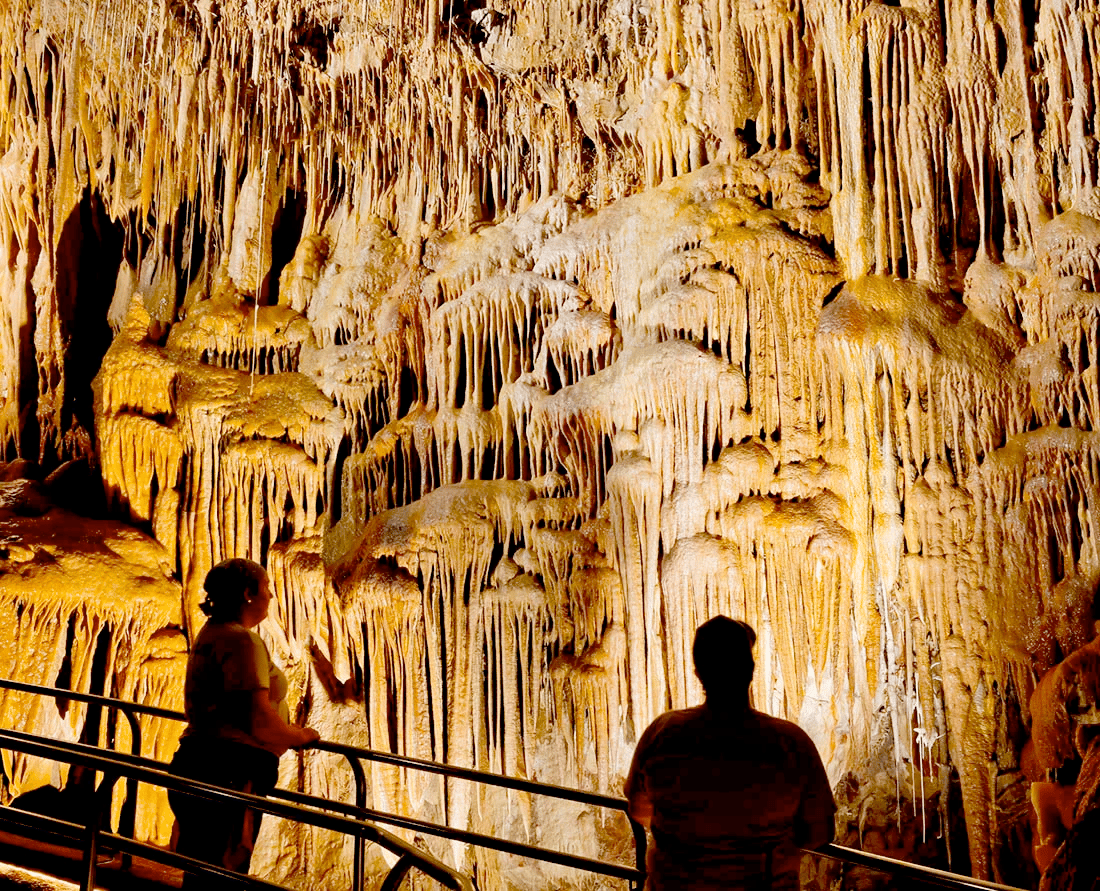
Kartchner Caverns … part of Earth’s mucous membrane?
And if you’re looking for an epic trail-conquering trophy, something new is in the works for Arizona, though you’ll have to wait another 10 years.
The Sun Corridor Trail will go from Las Vegas all the way down to Douglas, with lots of stops along the way. It’s been under development since 2013, and a couple years back it got $250,000 from the Az Dept. of Tourism to keep the wheels turning. Read more about it in Rails to Trails.

News from above
Starry sky high: The City of Bisbee was just christened as an International Dark Sky Community, joining the ranks of 220 other places around the world where local communities support the effort to keep the stars shining brightly above. Over the next five years, the city will convert all of its municipal lighting to dark-sky compliant fixtures.
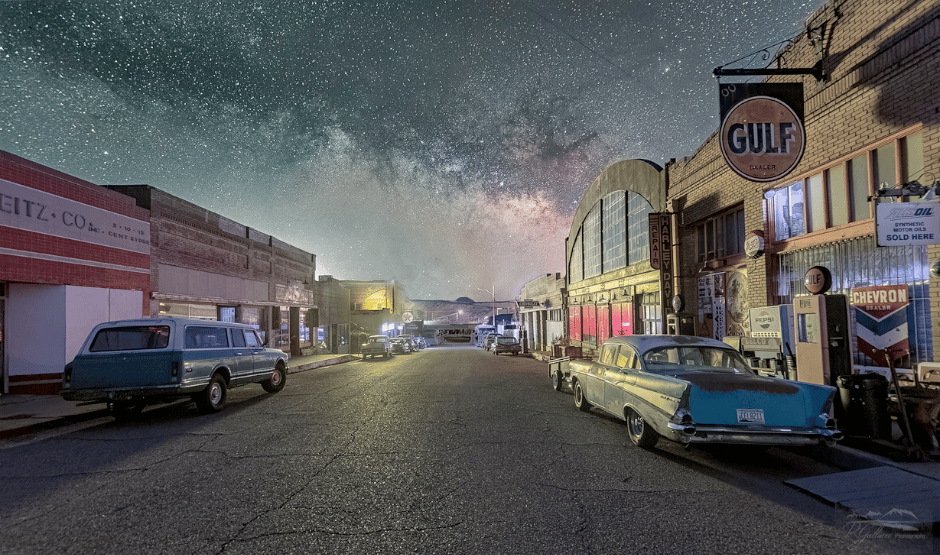
Time-lapse photo of Erie St. in Bisbee.
Not so fast: Federal agencies have voiced their concerns about the U.S. Air Force’s Tombstone MOA proposal, Shar Porier reports for the Herald/Review.
U.S Forest Service Coronado District Ranger Doug Ruppel says: “(The Air Force’s proposal would impact) wilderness values and solitude, as well as ecological processes throughout the area, but especially in the vicinity of Cave Creek, Southfork and the Chiricahua Wilderness. … The Forest Service has had several instances of wildland fire ignitions caused almost certainly by flares from Air Force training flights.”
The Environmental Protection Agency’s Francisco Dóñez wrote to the Air Force: "The assessment of noise does not adequately evaluate noise impacts since it uses an inappropriate methodology/significance criterion for the project’s noise emissions, which we had recommended against. … (Consider an) alternative that will not subject such a large area to very loud and sudden noise effects, which could have health and safety implications.”
The real pokémon of Cochise County: Did you know that sandhill cranes aren’t the only exotic birds that migrate to the Willcox Playa and Whitewater Draw this time of year? Scroll through the Cochise County Rare Bird Alert page to see where locals are spotting the most interesting birds in our area. The American Avocet, pictured below, is just one of many that you might see around our local wetlands this time of year.

Recurvirostra americana

It’s Cochēz, our mascot, giving the gift of good news.
Have you been thinking about supporting the Ground Party Papers? We barely missed the November goal of 50 subscribers, but I’ve got magic deadline-extending powers, so let’s keep going.
For just $60 a year, you can get that warm fuzzy feeling of helping out, and 24 editions of handcrafted news that come from right here in Cochise County. That’s the same price as a yo-yo or an inflatable slice of pizza.

A new sense of nuisance
Last week I published a piece in the Arizona Agenda about Attorney General Kris Mayes’ announcement of upcoming nuisance lawsuits against the megafarms Fondomonte (La Paz County) and Riverview (Willcox and Douglas Basins), and the legislators who are trying to protect those megafarms. It’s a big move by Mayes, and hard to predict the outcome given Arizona courts’ historic refusal to prosecute groundwater nuisance — but could be a game changer in rural Arizona and the Southwest if she wins.
Water news roundup
The other chem trails: The U.S. Air Force has finally agreed to help pay for cleaning up the PFAS contamination in Tucson’s groundwater, as demanded by the Environmental Protection Agency. The use of solvents and degreasers at the Morris Air National Guard base led to levels of “forever chemicals” in groundwater as high as 53,000 ppt (parts per trillion), while the legal limit is between 4 and 10 ppt. The underground contamination has been pluming out from the site and Tucson has already had to shut down 5 of their wells.
When in drought: How is Arizona’s 2024 looking on the historical weather scoreboards? It was the 32nd driest year on record, with the 17th driest monsoon season, and the hottest June-through-September period ever recorded. The outlook for the upcoming winter season is a slight La Niña, meaning warmer and drier than average as the jet stream flows toward the Pacific Northwest. KJZZ’s Mark Brodie sat down with UofA’s climatologist Mike Crimmins to talk about this year’s drought report — listen here.
Fun fact: If the current drought period were to suddenly reverse 50 years back, we’d have just a 15% increase in precipitation, roughly.
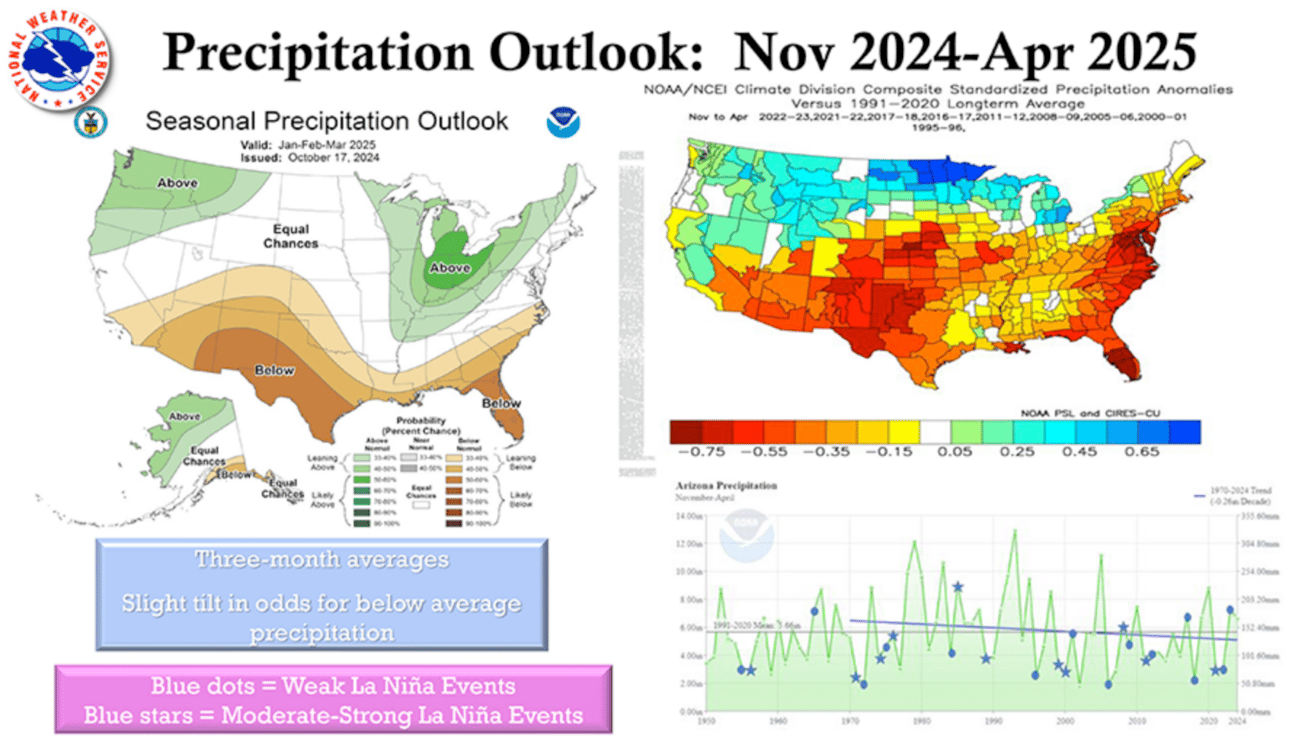
This water was made for you and me: Governor Hobbs signed off on two water rights agreements for the Navajo Nation, Hopi Tribe, San Juan Southern Paiute Tribe, and Yavapai Apache Nation, which would grant them a supply of water from the Colorado River and federal funding to build infrastructure to deliver that water to their communities. The settlements are now before the U.S. Congress for approval.
Crops-to-concrete: It seems most folks at the Capitol agree on one thing — Arizona needs to keep growing it’s population and grow less food. The ADWR has recently proposed a department-led ag-to-urban incentive program which they’ll be working on with the Governor’s Water Policy Council. Earlier this year, the Republicans pushed their own ag-to-urban legislation but it was vetoed by Hobbs. Even among stakeholders who agree with the general strategy, some felt that the bill allowed too much residential development and could actually worsen groundwater overdraft. Governor Stephen Roe Lewis of the Gila River Indian Community said this about the vetoed bill:
“This bill was the product of closed-door meetings of one set of stakeholders who purposefully sought to keep out anyone who raised legitimate questions about the bill … I specifically asked to participate in these meetings beginning in February and was told I was not welcome.”
Assured water controversy: On a similar note, Hobbs and ADWR are pushing for an update to Arizona’s “assured water supply” policy that requires new residential developments to prove a 100-year water supply which ensures that home buyers don’t find themselves without water down the road. They’re proposing that developers can get around the rule if they secure non-groundwater sources of water and a percentage of that water goes into the aquifer to offset current overdraft. But Big Development doesn’t like the idea because it will eat into their profits. KJZZ’s Camryn Sanchez reports.

You don’t choose to be a “water policy guy” — it chooses you.
Water is the new Bitcoin: Investment company Global Water Resources has been buying out public water utilities in Arizona, and some communities aren’t psyched about it. Dan Holladay of Thunderhead Ranch is hoping his community’s water supply can continue under Tucson Water management, 13News reports.
“Global Water has a terrible track record of raising rates, assessing people’s fees, hidden fees, and really poor customer service,” Holladay said.
And who regulates the water companies?: The Arizona Corporation Commission is in charge of making sure utilities set fair rates for their customers. But as I reported earlier in the year for the Arizona Agenda, the majority Republican commissioners have a history of getting cozy with corporations. And they’ve recently decided to allow utilities to use a faster rate-adjustment process, called “formula rate plans”, which has less public oversight. 12News reports that the independent council hired by the commission said the new policy won’t be good for consumers:
“Formula rate plans have resulted in large rate increases with very few rate decreases and no measurable improvement in reliability of service,” said consultant Michael Deupree.
Alternative Building

Step aside, Portland
The very first issue of the Ground Party Papers included a segment on locally sourced geopolymers, an alternative to Portland cement. Here’s two more cement alternatives making a name for themselves in Arizona:
Ferrock is a compound made from recycled steel dust and pulverized glass, discovered accidentally by UofA student Dr. David Stone back in 2012. Last year, researchers carried out an extensive analysis of the material and showed that’s it out-competes Portland cement on several metrics: 13.5% better for compressive strength; 20% for split tensile strength; and 18% for flexural strength.
And a Phoenix-based company took note of the “spray cork” technology gaining popularity in Europe and Australia and decided to bring it to the states. This replacement for stucco is made with actual cork, which turns out to be insulating, sound damping, flexible, and resistant to fire, liquid, and gas. And today I learned that cork oak trees are the only trees besides cinnamon and maple which regenerate their bark — the cork bark can be harvested 17 times over the 200 year lifespan of the trees.

Our neighbors in New Mexico
An Arizona news team trekked over to Taos to talk with the community of 200 Earthshippers about their life off the grid and the benefits of natural building.
"I'm using five gallons — or three gallons of water to take a shower. That same three gallons of water waters my banana trees and my tomatoes. That same three gallons of water is recollected to flush the toilet."
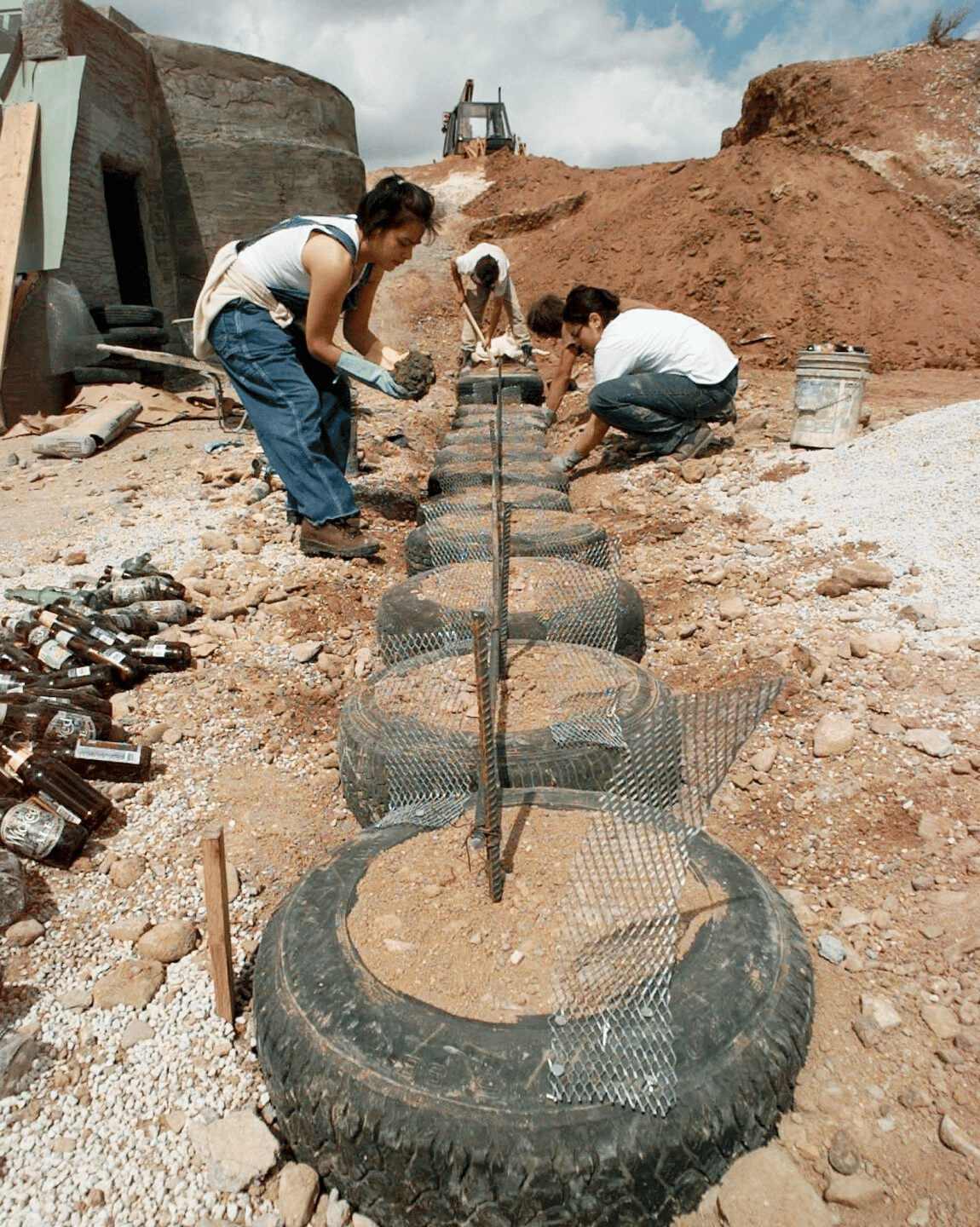
"You know, on a cold February night, you walk in one of these and you go, 'This is amazing.’ This is warm and it's freezing outside and there's no heating system here."
Read ABC15’s full story and watch their video segment here.
If you enjoyed this newsletter, forward it to a friend.
And…
Thanks for reading!
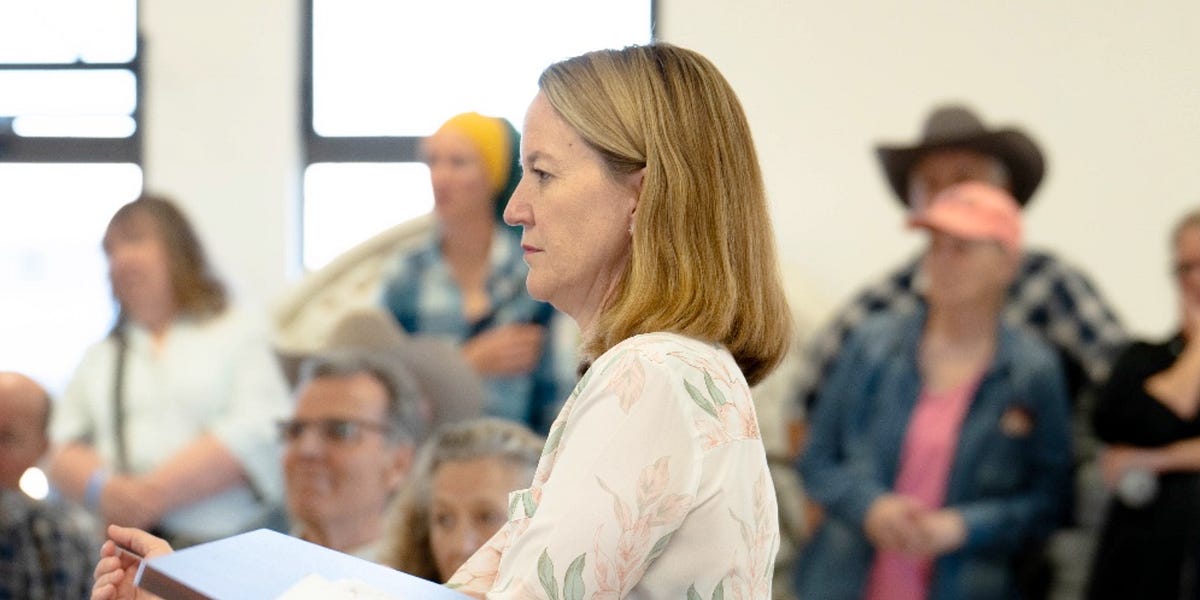
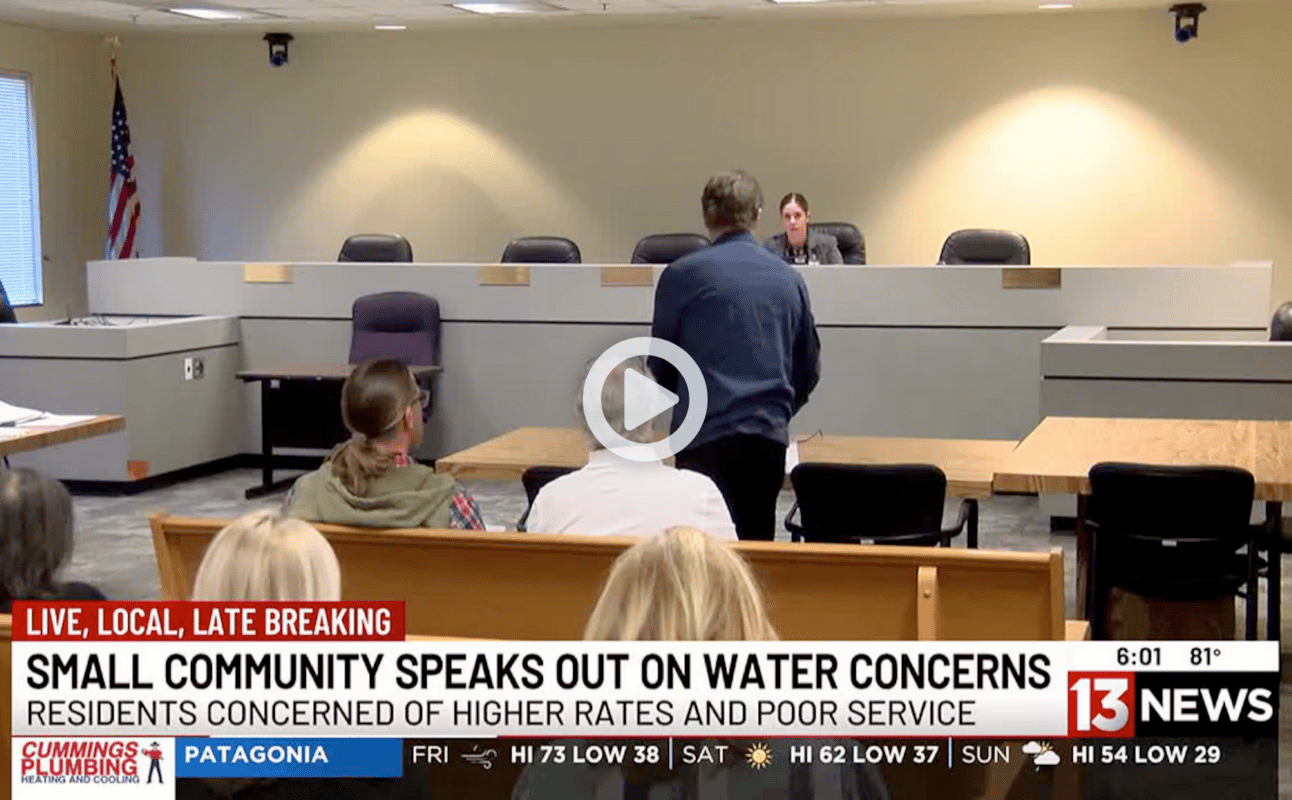
Reply